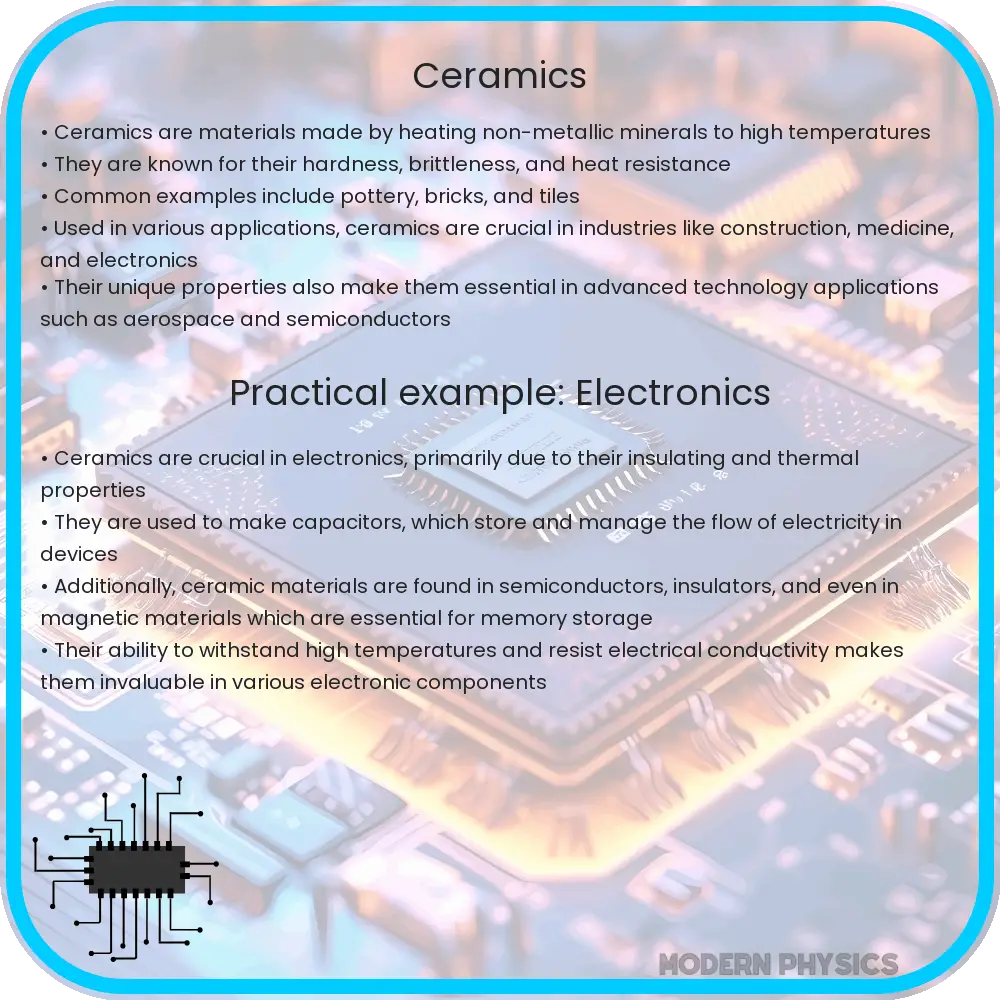Uncover the diverse world of ceramics, highlighting their essential role in material science, versatile applications, and technological innovations.

Exploring the World of Ceramics: The Cornerstone of Material Science
Ceramics, a category of materials that are often perceived as traditional and fragile, actually encompass a highly diverse group of materials whose applications stretch from ancient pottery to state-of-the-art technological advancements. These materials are primarily compounds of metallic and non-metallic elements such as aluminum, silicon, and oxygen. The characteristics like high melting points, low electrical conductivity, and high compressive strength make ceramics a key player in the fields of materials science and engineering.
Durability of Ceramics
When it comes to durability, ceramics are typically very hard. This hardness is primarily due to the type of bonding between atoms in the ceramic materials—ionic and covalent bonds. These bonds are significantly stronger than the metallic bonds found in metals, enabling ceramics to withstand high pressures and temperatures. Another aspect of ceramic durability is their chemical inertness. Most ceramics can resist corrosion and degradation by chemicals, making them ideal for applications where high endurance is essential, such as in liners for rocket engines, biomedical implants, and even as non-reactive surfaces in chemical processing equipment.
Versatility in Applications
The versatility of ceramics stems from their varied composition and manufacturing processes. Depending on their makeup and how they are produced, ceramics can be made incredibly dense and strong or given porous qualities with lightweight characteristics. This adaptability allows them to be used in a plethora of applications. For everyday uses, ceramics are prominent in household items such as dishes, tiles, and even glass. Meanwhile, in technology, ceramics find their place in electronic devices as insulators and semiconductors. Furthermore, specialized ceramics known as technical or advanced ceramics are crucial in applications demanding materials that can withstand harsh environments, such as in aerospace (heat shields, turbine blades) and defense (armor plating).
Innovation in Ceramic Materials
Recent innovations in ceramic technology are pushing the boundaries even further. Researchers are developing ceramics with incredible toughness and resilience by manipulating their microstructures or by creating composite materials. For instance, ceramic matrix composites (CMCs) combine ceramics with metal or carbon fibers to enhance properties like fracture toughness and thermal stability. Innovations like these open new avenues for ceramics in fields such as renewable energy (as substrates in solar panels), electronics (in advanced semiconductors), and even biomechanics (for prosthetic limbs with improved compatibility and durability).
The role of ceramics in modern technology is molded by their inherent properties and enhanced by groundbreaking research and development. Understanding the science underlying these materials helps in appreciating their versatility and potential to impact various fields.
Environmental Impact of Ceramics
Ceramics also play a significant role in environmental sustainability. Due to their durability and resistance to corrosion, ceramic products tend to have a longer lifespan compared to plastics and metals, which contributes to reduced waste and lower consumption of raw materials. Moreover, they are inherently more energy-efficient in certain applications such as insulating components in electrical devices and thermal insulations in buildings. The inert nature of ceramics ensures that they do not leach chemicals into the environment under normal conditions, promoting a cleaner and safer ecosystem.
Educational and Economic Impact
The production and research of ceramic materials also drive substantial educational and economic benefits. Programs in material science and engineering that focus on ceramics produce graduates equipped to handle complex challenges in manufacturing, aerospace, electronics, and more. This expertise translates into economic benefits as well; the global ceramics market is vigorously expanding, supported by advancements in ceramic science and increasing demand in various industries. This economic growth fosters job creation and stimulates further research investments in the field.
Future Prospects of Ceramic Technology
Looking ahead, the future of ceramics appears vibrant and promising. With ongoing advancements in nanotechnology and materials science, researchers are focusing on developing smarter ceramics that have self-healing abilities, are lighter, yet more durable, and possess adaptive features such as temperature responsiveness. These developments could revolutionize industries like construction, where materials capable of adjusting their properties according to environmental changes can significantly enhance efficiency and safety.
Conclusion
In conclusion, ceramics extend far beyond traditional pottery and fragile ornamentals – they are integral to modern engineering and technology, standing at the forefront of material innovation. They contribute durability, versatility, and sustainability to everyday applications and high-tech environments alike. Ongoing research in ceramic technology not only pushes the limits of what these materials can achieve but also continuously redefines their role in a rapidly changing world. As we further our understanding and improve the functionalities of ceramics, their impact on technology, the environment, and economy is sure to expand, offering new solutions to some of the most pressing challenges of our time.
